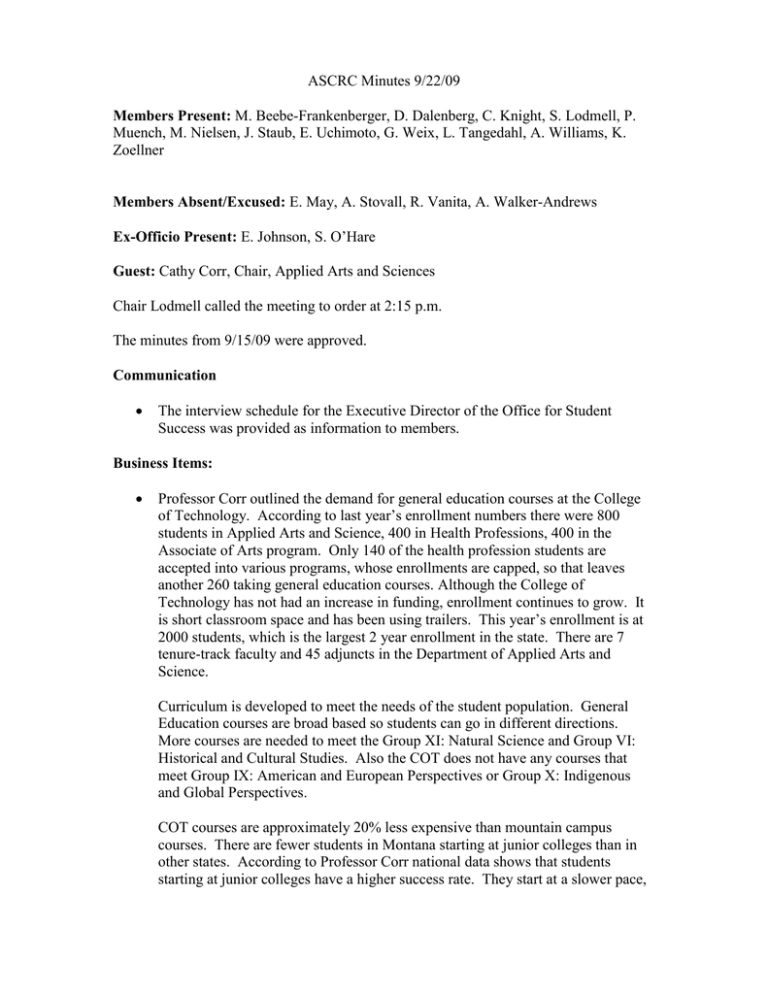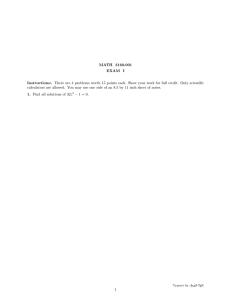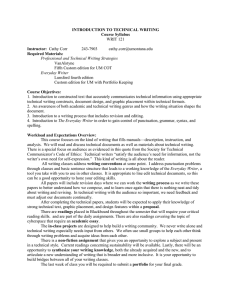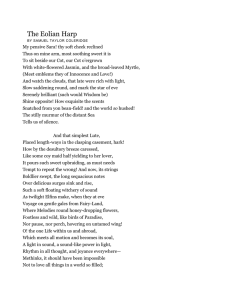Muench, M. Nielsen, J. Staub, E. Uchimoto, G. Weix, L.... Chair Lodmell called the meeting to order at 2:15 p.m.
advertisement

ASCRC Minutes 9/22/09 Members Present: M. Beebe-Frankenberger, D. Dalenberg, C. Knight, S. Lodmell, P. Muench, M. Nielsen, J. Staub, E. Uchimoto, G. Weix, L. Tangedahl, A. Williams, K. Zoellner Members Absent/Excused: E. May, A. Stovall, R. Vanita, A. Walker-Andrews Ex-Officio Present: E. Johnson, S. O’Hare Guest: Cathy Corr, Chair, Applied Arts and Sciences Chair Lodmell called the meeting to order at 2:15 p.m. The minutes from 9/15/09 were approved. Communication The interview schedule for the Executive Director of the Office for Student Success was provided as information to members. Business Items: Professor Corr outlined the demand for general education courses at the College of Technology. According to last year’s enrollment numbers there were 800 students in Applied Arts and Science, 400 in Health Professions, 400 in the Associate of Arts program. Only 140 of the health profession students are accepted into various programs, whose enrollments are capped, so that leaves another 260 taking general education courses. Although the College of Technology has not had an increase in funding, enrollment continues to grow. It is short classroom space and has been using trailers. This year’s enrollment is at 2000 students, which is the largest 2 year enrollment in the state. There are 7 tenure-track faculty and 45 adjuncts in the Department of Applied Arts and Science. Curriculum is developed to meet the needs of the student population. General Education courses are broad based so students can go in different directions. More courses are needed to meet the Group XI: Natural Science and Group VI: Historical and Cultural Studies. Also the COT does not have any courses that meet Group IX: American and European Perspectives or Group X: Indigenous and Global Perspectives. COT courses are approximately 20% less expensive than mountain campus courses. There are fewer students in Montana starting at junior colleges than in other states. According to Professor Corr national data shows that students starting at junior colleges have a higher success rate. They start at a slower pace, are in smaller classes, and have one-on-one advising. The University needs to do a better job of tracking the students that transfer from the COT. The strategic planning goal to fully integrate the College of Technology into the fabric of UM pertains to the development of more 2 +2 programs, as well as the COT functioning as a feeder into the mountain campus. Proposals are coming forward for a 2+2 in Social Work and an AA in Indigenous Studies. Mary Moe, the Associate Commissioner, would like all MUS two year schools to have a standalone AA program. It was suggested that a vision statement be created for the development of general education and other new courses over the next several years. COT general education courses should correspond with the COT curriculum. This will guide the coordination and alleviate concerns of duplication. Professor Corr was enthusiastic about consulting with her colleagues at COT to work on a vision statement. The audit catalog language (appended below) was approved. Interim Registrar Johnson will follow-up with regard to the feasibility of adding –unacceptable attendance category to the grading option drop down menu. Another possibility will be to use the “last date of attendance function”’. Faculty will need to be reminded of the audit policy and make a note on the syllabus about attendance/ performance expectations. The editorial catalog language procedure was updated to include: Simple course number, rubric, title changes to abide by common course numbering. Members should think about what might be helpful information for ASCRC to send to faculty at the beginning of the semester. It was suggested that a brief memo be sent that explains the committee’s curriculum review process. Good and Welfare There is some concern regarding courses that are team taught and have frequent guest lecturers and excessive use of film in lieu of active teaching. The consensus opinion was that ASCRC’s role is not to monitor faculty or extant course content except possibly in instances in which there have been complaints or formal requests for review or intervention. Subcommittees should be mindful of pedagogical issues when reviewing syllabi. If there is a problem, it should be brought to the attention of the department chair and or dean. The meeting was adjourned at 3:50. Auditing a course A student may elect to register for a course as an auditor of the course without earning credit or being graded. On the academic transcript AUD is recorded for all students who register in courses as auditors. The same fees are assessed as when registering for credit. Attendance and participation expectations are established by the instructor of the course. If attendance and participation expectations are not met, the instructor may request a notation be placed on the student's academic record indicating attendance and/or participation was not satisfactory.





